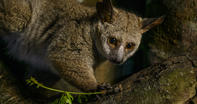
Appearance
The thick-tailed bushbaby is the largest of the galago species. Its head and body measures from 297 to 373 mm, and its tail from 415 to 473 mm. Males are significantly larger than females. Its coat is silvery brown to grey of colour, with a lighter underside. Its fur is thick, woolly, wavy and quite long.
They tend to roll and unroll their ears, and with their large eyes give them a quizzical expression. As with most galago species, the thick-tailed bushbaby has long fingers and flattened toes and nails. The pads of thickened skin at the end of its fingers and toes gives grip in grabbing branches.
Thick-tailed Bushbaby Diet
Thick-tailed bushbabies are largely gumivorous and frugivorous, meaning they feed on the gum and saps of trees, insects and fruits. A study conducted in South Africa showed that their diet mainly consists of gums, supplemented by fruits and insects. However, the bushbabies of Kenya’s diet may consist of 50 to 70% insect, whereas in Gauteng insects compromise only 5% of their diet.
The large termite (macrotermes falcigar) is the bushbaby’s seasonal food supply, and is eaten off the ground without the use of hands. Their diet generally consists of insects, fruit, leaves, lizards, eggs, birds and flowers.
Thick-tailed Bushbaby Breeding
The birth season of the thick-tailed bushbaby varies according to its locality. The oestrus cycle lasts about 44 days. In the Gauteng area, the birth season is limited to November, whereas it occurs during August and September in Zambia. In Zanzibar and Pemba, pregnancies peak in August. A litter of two, and sometimes three, are born after 133 days of gestation.
While females go to forage, they leave their young in the tree. They produce a rich, energy-dense milk, particularly in comparison to the milk produced by other anthropoid primates. The richness of the thick-tailed bushbaby’s milk may be due to their habit of not carrying their young with them during lactation, as other anthropoid primates do.
Nests are made for the young in the tangles of vegetation. The thick-tailed bushbaby gives birth once a year when vegetation is dense. It has been reported from studies in captivity, however, that this species has continuous oestrus cycles and thereby able to give birth throughout the year. The young become independent of their mothers at the age of 4 to 5 weeks, and both males and females reach sexual maturity at about 20 months.
Thick-tailed Bushbaby Behaviour
The thick-tailed bushbaby is the most social of all known bushbabies, showing a social network without the structure of a foraging group. Unlike other galagines, they move through the forest and bush quadrupedally by hopping and landing on their hind legs after jumping. Being nocturnal, the thick-tailed bushbaby is active for 9.5 hours per day during summer, and 12 hours per day during winter.
Males disperse from their birth territory at a younger age and further than females, fluctuating the male membership in populations more so than the female. This may be a habit to lessen complications of inbreeding. Thick-tailed bushbabies share their ranges with younger or older individuals, but not with those of their own age. Males are territorial and have home ranges which overlap with one or more females. Females are dominant in this species.
Studies conducted in captivity found that males are more likely to follow females, and females act aggressively towards them. In social play, they perform an exaggerated walk, chase, pull tails, wrestle, pounce and bite one another non-aggressively. When infants are independent of their mothers at about five weeks of age, they tend to play more. Thick-tailed bushbabies sleep in nests 5 to 12 metres from the ground, and sleep there together during the day. At night, they split up to forage traversing about one kilometre through the night.
They live in small groups of 2 to 6 individuals of varying compositions. A group could consist of an adult pair and their young, two adult females with young, or one adult female with young. They have the habit of cupping their hands, depositing urine therein to spread on the soles of their feet. When walking, they mark their urine on the ground.
This behaviour is seen more frequently in males, particularly when the female is in her oestrus cycle. The male, of all age classes, then urinates onto the female. Urine-washing occurs when the thick-tailed bushbaby is foraging in a new area, confronted with a strange object, during aggressive encounters, and in social grooming. Dominant individuals engage in this behaviour more frequently.
 Learning about the mammals of South Africa is now so much easier for all South Africans - SouthAfrica.co.za is an excellent source of inform...
Learning about the mammals of South Africa is now so much easier for all South Africans - SouthAfrica.co.za is an excellent source of inform...